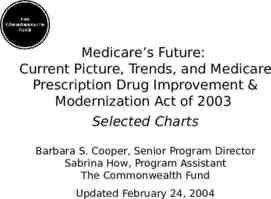Eating Disorders 101 NationalEatingDisorders Helpline:
40 Slides3.66 MB
Eating Disorders 101 www.NationalEatingDisorders.org Helpline: myneda.org/helpline Business Line: 212-575-6200
What Are Eating Disorders? Life-threatening Extreme emotions and behaviors surrounding weight, food & size Biological, psychological & sociocultural factors www.nationaleatingdisorders.org
Who Do Eating Disorders Affect? www.nationaleatingdisorders.org
Biopsychosocial Disorders Biological Factors: – Family history – History of dieting – Type One (Insulindependent) Diabetes – Genetic predisposition Psychological Factors: – Low self esteem – Relationship with self – Feelings of inadequacy – Depression, anxiety, fear, or loneliness www.nationaleatingdisorders.org Social Factors: – Cultural norms that overvalue appearance – Body dissatisfaction – Drive for perceived ideal body type – Historical trauma – Weight stigma/bullying
The 9 Truths About Eating Disorders 1. Many people with eating disorders look healthy, yet may be extremely ill. 2. Families are not to blame, and can be the patients’ and providers’ best allies in treatment. 3. An eating disorder diagnosis is a health crisis that disrupts personal and family functioning. www.nationaleatingdisorders.org
The 9 Truths About Eating Disorders 4. Eating disorders are not choices, but serious biologically influenced illnesses. 5. Eating disorders affect people of all genders, ages, races, ethnicities, body shapes and weights, sexual orientations, and socioeconomic statuses. 6. Eating disorders carry an increased risk for both suicide and medical complications. www.nationaleatingdisorders.org
The 9 Truths About Eating Disorders 7. Genes and environment play important roles in the development of eating disorders. 8. Genes alone do not predict who will develop eating disorders. 9. Full recovery from an eating disorder is possible. Early detection and intervention are important. www.nationaleatingdisorders.org
An Overview to Eating Disorders WARNING SIGNS, SYMPTOMS & HEALTH CONSEQUENCES
Warning Signs & Symptoms https://www.youtube.com/watch?time continue 133&v nJMtReAg1DI www.nationaleatingdisorders.org
Common Warning Signs EMOTIONAL/BEHAVIORAL PHYSICAL Weight loss, dieting, and control of food are primary concerns Food rituals Social withdrawal Frequent dieting, body checking Extreme mood swings www.nationaleatingdisorders.org Noticeable weight fluctuations Gastrointestinal complaints Dizziness upon standing Difficulty concentrating, sleeping Issues with dental, skin, hair, and nail health
DSM-5 Diagnoses Anorexia Nervosa Bulimia Nervosa Binge Eating Disorder OSFED ARFID www.nationaleatingdisorders.org
Anorexia Nervosa (AN) Characterized primarily by self-starvation and excessive weight loss Symptoms include: – Inadequate food intake leading to a weight that is clearly too low – Disturbance in the experience of body weight or shape – Intense fear of weight gain, obsession with weight, and persistent behavior to prevent weight gain – Inability to appreciate the severity of the situation www.nationaleatingdisorders.org
Bulimia Nervosa (BN) Characterized by binge eating and compensatory behaviors, such as self-induced vomiting, in an attempt to undo the effects of binge eating. Symptoms include: – Frequent episodes of consuming very large amounts of food followed by behaviors to prevent weight gain, such as vomiting, laxative abuse, and excessive exercise – Feeling of being out of control during the binge-eating episodes – Extreme concern with body weight and shape – Most people are of a normal weight www.nationaleatingdisorders.org
Binge Eating Disorder (BED) Characterized by recurrent binge eating without the regular use of compensatory measures to counter the binge eating. Symptoms include: – Indications that the binge eating is out of control, such as eating when not hungry, eating to the point of discomfort, or eating alone because of shame about the behavior – Feelings of strong shame or guilt regarding the binge eating www.nationaleatingdisorders.org
Avoidant-Restrictive Food Intake Disorder (ARFID) Characterized by lack of interest in food, fears of negative consequences of eating, and selective or picky eating. Symptoms include: – Reduced food intake and frequent complaints of bodily discomfort with no apparent cause – Lack of appetite or interest in food, with a range of preferred foods narrowing over time www.nationaleatingdisorders.org
Other Specified Feeding or Eating Disorder (OSFED) A feeding or eating disorder that causes significant distress or impairment, but does not meet the criteria for another feeding or eating disorder. Atypical Anorexia Nervosa: criteria for AN met but weight is not low Subthreshold Bulimia Nervosa: criteria for BN met but with less frequent behaviors Subthreshold Binge Eating Disorder: criteria for BED met but occurs at a lower frequency Purging Disorder: purging without binge eating Night Eating Syndrome: excessive nighttime food consumption www.nationaleatingdisorders.org
Common Comorbidities Depression Anxiety OCD Alcohol & substance use Self-harm PTSD www.nationaleatingdisorders.org
Health Consequences Cardiovascular (muscle loss, low or irregular heartbeat) Gastrointestinal (bloating, nausea, constipation) Neurological (difficulty concentrating, sleep apnea) Endocrine (hormonal changes – estrogen, testosterone, thyroid) www.nationaleatingdisorders.org
Serious, Potentially Fatal Illnesses Eating disorders have the second highest mortality rate of all mental health disorders, surpassed only by opioid addiction. Risk of death from suicide or medical complications is markedly increased for individuals with eating disorders. A study on BN and EDNOS found elevated mortality risks similar to those for AN, despite being sometimes viewed as “less severe” www.nationaleatingdisorders.org
Self-identification & Weight Stigma BARRIERS TO CARE
Barriers to Self Identification Often an individual with an eating disorder does not believe they have a problem. Many people with eating disorders look healthy, yet may be extremely ill. Eating disorders are often viewed as a disease that only affects affluent, white women. www.nationaleatingdisorders.org
What is Weight Stigma? Discrimination or stereotyping based on a person’s weight. Risk factor for depression, body dissatisfaction, and low self-esteem. Increases the risk of eating disorder symptoms. www.nationaleatingdisorders.org
Weight Stigma in Healthcare Research shows that healthcare providers, when talking to obese patients, tend to: –Provide them with less health information –Spend less time with them –View them as undisciplined, annoying, and noncompliant with treatment. www.nationaleatingdisorders.org
Do you have higher weight bias? https://implicit.harvard.edu/implicit/takeatest.html www.nationaleatingdisorders.org
Help is Available! SEEKING TREATMENT
Serious, Life-Threatening, & Treatable Eating disorders are not fads or phases, and they have the second highest mortality rate of any psychiatric disorder, surpassed only by opioid addiction. Serious effects on health, productivity, and relationships Early intervention increases likelihood of a full recovery. www.nationaleatingdisorders.org
Eating Disorders Treatment Ongoing Support Intervention Professional Treatment www.nationaleatingdisorders.org Recovery
Individualized Care TREATMENT PROCESS Initial assessment/diagnosis Interview providers Communicate with all involved Develop a maintenance plan www.nationaleatingdisorders.org
Levels of Care Inpatient Residential Partial hospitalization Intensive outpatient Outpatient www.nationaleatingdisorders.org
Where to Find Help SUPPORT & RESOURCES
Helpline phone hours are Monday-Thursday from 11AM to 9PM ET, and Friday from 11AM to 5PM ET. Helpline chat hours are Monday-Thursday from 9AM to 9PM ET and Friday 9AM to 5PM ET. 24/7 crisis support: text “NEDA” to 741741 www.nationaleatingdisorders.org
Eating Disorder Screening Tool 97% of participants identified as at-risk Over 400,000 screenings taken from 2018-2019 Quick access to help www.nationaleatingdisorders.org
NEDA Toolkits www.nationaleatingdisorders.org
Brochures www.nationaleatingdisorders.org
How to Help DO: DON’T: Learn as much as you can about eating disorders Place shame, blame, or guilt Be honest and vocal about your concerns Be caring and firm Suggest they seek help from a physician and/or therapist Be a good role model, practice what you preach www.nationaleatingdisorders.org Make rules or promises that you cannot or will not uphold Give simple solutions Invalidate their experience or try to convince Give advice about weight, exercise, or appearance Ignore or avoid the situation until it is severe or life-threatening
How to Help a Loved One https://www.youtube.com/watch?v fX1CFDtdgbY www.nationaleatingdisorders.org
Talking about Eating Disorders KEEP IN MIND: Don’t provide tips or play the numbers game. Emphasize the seriousness of eating disorders without portraying them as hopeless. www.nationaleatingdisorders.org Watch out for the appearance ideal. Don't focus on images or descriptions of the body at its unhealthiest point.
The Body Project Train-the-trainer model 450 trained Repeatedly shown to effectively reduce body dissatisfaction, negative mood, unhealthy dieting, and disordered eating 2-hour experiential version available www.nationaleatingdisorders.org
The Body Project “Now that I have done the Body Project, I have noticed that I see my body more positively now and I stay away from negative comments. I am also doing this with my family members and staff around me.” www.nationaleatingdisorders.org
Get Involved With NEDA! To learn more, contact: Business: (212) 575-6200 NEDA Helpline: myneda.org/helpline Email: [email protected] www.nationaleatingdisorders.org













































